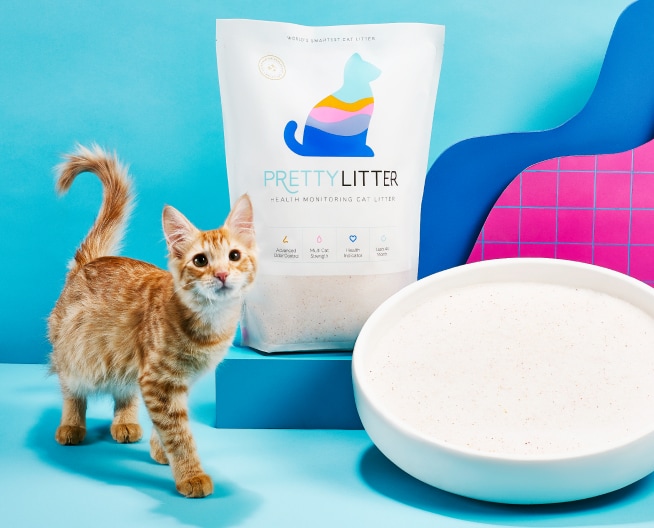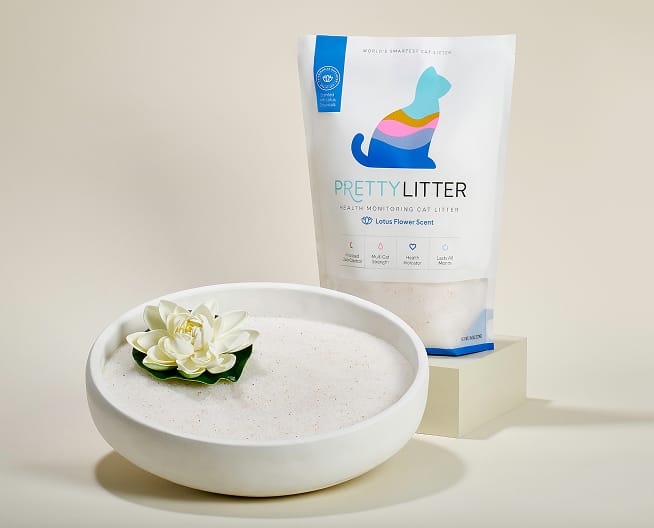February 3, 2023 |7 min read
How To Dispose of Cat Litter: 3 Ways

Written by

One of the most important things to keep in mind as a new cat owner is keeping your cat’s litter box clean. When we adopt a new cat, we sometimes get caught up in the excitement of having a new furry friend in our lives and forget that taking care of a new cat comes with a lot of responsibility. Especially when it comes to litter training, knowing when to change cat litter, and how to dispose it properly. As a new cat owner you must be wondering, what are some of the best ways to keep your cat’s litter box clean, when should you dispose of said litter and how should you dispose of it?
Our experts at PrettyLitter did some digging and found 3 different ways people get rid of their cat litter… and which way we ultimately recommend!
Three Ways to Dispose of Your Cat’s Litter
1. Throwing it away in the trash.
When disposing of your cat’s litter, sometimes the classic way is the best. Disposing of their litter by scooping it all up in a heavy-duty garbage bag, tying it up, and throwing it away in the trash is proven to be the most effective way of getting rid of their waste while reducing the risks of exposure to certain bacteria in feline feces.
Using a cat litter scoop, sift out the urine and poop from the litter, then place all the waste into a trash bag. Investing in heavy-duty, biodegradable trash bags will reduce the risk of your bag tearing if it’s too full or heavy with the mix of litter and waste it’s carrying.
Being biodegradable will allow for your cat’s waste and litter to decompose naturally over time with very little impact on the surrounding ecosystem. Place the bag in your trash can before scooping the litter into the bag.
This way it's easier for you to scoop it all in without making even more of a mess than holding the bag open. Once the trash bag is full, tie it into a knot, and double bag it to prevent litter spilling out and odor/bacteria leakage.
Throw out the double-bagged litter into an outside trash can with a lid that fits over it tightly. Never scoop out your cat’s litter and let it sit in your trash can for too long. The longer it’s in there, the smellier it will get and the greater the risk of being exposed to bacteria will be.
2. Composting the litter.
An arguably eco-friendlier way for getting rid of your cat’s litter is by composting it. Now,
not all litter is biodegradable, so composting is not the end-all, be-all of getting rid of litter.
Types of litter that are biodegradable and able to be composted are clay-based litters, corn-based litters, wheat-based litters, and litters made out of compressed paper.
However, before you go this route, you should keep in mind that cat feces carry a plethora of bacteria even worse than the likes of E. Coli.
For example, cats infected by the parasite Toxoplasma Gondii will readily expel more of this parasite in their waste. When this parasite is in the environment, the bacteria can very easily infect other animals and humans.
While toxoplasmosis won’t cause clinical issues in most healthy adults, it could seriously affect a pregnant woman if she comes in contact with the bacteria. It can cause complications to the fetus.
If you decide that you still want to dispose of your cat’s litter by composting it, sources say to never compost it on edible vegetable gardens and to only use it on flower gardens (ie: rose beds).
Some people prefer composting in buckets and bins in their backyard than fully in the ground whereas others prefer composting in-ground in their backyards. A pro to composting in a bucket or a specialized composting bin is that it’s easier to manage in a home or apartment with limited outdoor space.
This way is better for cat owners with only one cat. Outdoor, in-ground composting is better for households with more than one cat. When composting in the ground outside, it is incredibly important to avoid any water sources as to not contaminate your water if the compost were to get wet and runoff.

3. Flushing it down the toilet (read your product labels).
Since humans regularly use the toilet to expel our waste, some of us might be
considering getting rid of our cat’s waste in the same fashion. In most cases, this is not the best way to dispose of your cat’s litter.
While there are some litters that are considered “flushable” (ie: corn-based and wheat-based litters), most common litter such as clay-based, silica-based, newspaper-based litters clump way more easily and could negatively impact your pipes and plumbing.

If you’re flushing a type of litter that is confirmed to be “flushable”, only flush a few scoops at a time to not clog your toilet. Another biodegradable litter that is confirmed to be flushable is pine-based litter made from pine logs. This material easily binds with your cat’s waste and disintegrates very easily.
Standard clumping litter should never, ever be flushed down a toilet. They can cause serious damage to your plumbing. Another downside to flushing any kind of litter is the risk of bacterial exposure.
Most toilets do not have a water filtration system that will 100% get rid of bacteria found in cat or human feces. Since many cat feces carry dangerous parasites like Toxoplasma Gondii, flushing litter down the toilet is highly discouraged
Knowing where to put the litter box and keeping your cat’s litter box clean and hygienic will keep them coming back for more! Always remember to never fill it over 2-3 inches, scoop out the cat waste daily and clean out the litter box weekly. Learn more about how much cat litter to use. Investing in a stainless steel litter box will also reduce bacteria build-up, unlike plastic litter boxes which are hotbeds for bacteria. Remember the best way to dispose of your cat’s litter is the old-fashioned way: tying it up in a heavy-duty bag and throwing it out in the garbage.
Sources:
https://www.hepper.com/how-to-dispose-of-cat-litter/
https://www.caticles.com/litter-box-hacks-genie-organization/
https://www.treehugger.com/dispose-of-cat-litter-the-green-way-5025649









